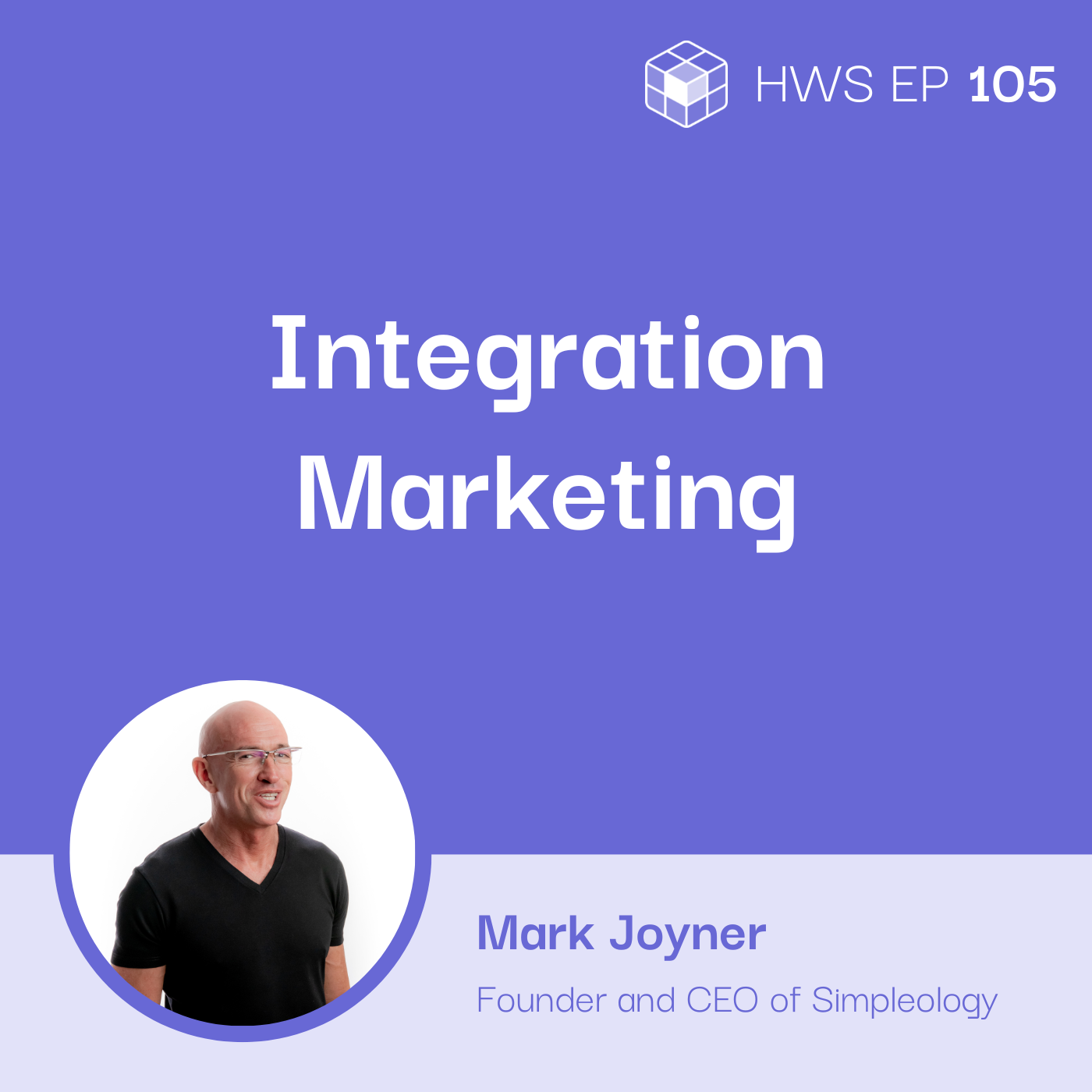Listen on:
Table of Contents:
Problem: How can small businesses leverage integration marketing for reliable growth?
What do big corporations like McDonald’s, Microsoft, and Amazon have in common? How did they grow from small businesses to global corporations? What have they done right? Today’s guest Mark Joyner talks about Integration Marketing. How can small businesses grow methodically and reliably through integration marketing?
It was a transaction stream. IBM was selling these computers to other people. So, what does this mean? When you understand that, the cost of acquiring a new customer. This is sort of a marketing truism, and this always obviously varies. It’s not a perfect benchmark, but it tends to be about 10 times the cost of selling to an existing customer. What did Bill Gates do? He had handed to him, on a silver platter, an endless stream of customers that he never had to spend a dime.
The Four Integration Marketing Cash Cows
Integration Marketing is more than a tactical approach to business growth — it’s a strategic platform upon which to build and develop. Mark simplified an innovative and effective system to help companies find hidden marketing opportunities. The goal is to see which of these four opportunities will bring in a limitless supply of new customers to help grow your business steadily and predictably.
It’s like Amazon, you know? I tell people, “Hey, look, customers are not yours. You’re just in temporary possession of their attention. And if you’ve shot all of your marketing bullets to these guys, you’re being dumb. Of course, you don’t want to tell them you’re being dumb. That’s probably not the best way to convince them. But you want to point out to them, “Hey, if you should already shoot all your bullets, wouldn’t it be wise to have some other messaging for these guys so that you can make some more money?” They understand that, and they go, “Oh, wait a minute. So, this isn’t giving away my business?” This is making me more profitable in the long term.
Opportunity #4: Integrating Into an Existing Traffic Stream
Mark coined the term UMV or Unit of Marketing Value. He suggests finding opportunities to integrate your products or services into an existing traffic stream.
So there are what I call the four integration marketing cash cow opportunities. The cash cows are different ways that you can benefit from. Now, there’s the traditional way that most people think about, which is what I call the UMV owner. That’s opportunity number four. You’ve got a product or a service or an ad or something that you want to integrate into somebody else’s traffic or transaction stream.
Opportunity #3: Using Traffic Streams as Additional Source of Income
The traffic stream is a potential integration point where you have a platform that brings in more eyeball and reach. These streams help brands to gain exposure. Other than renting out the space physically or virtually, others make more money recommending the products or services they promote. As a result, traffic stream owners offer more incentives or payments to promote or recommend their products. In turn, product and service owners grow their sales regularly and steadily. The traffic stream owners also get a steady income from their streams instead of erratic bookings.
So if it’s somebody who owns a source of a traffic stream. It’s just basically anywhere where people are, whether it’s online or off, on a billboard— it’s a traffic stream. Some know it’s a potential integration point, where you could put a message there. I’ve sold billboards in the past, they generally rent out the space. But very clever people would go to somebody who has a traffic stream like that and say, “Hey, you can sell your ad space. But why don’t we do it like this? I’m going to give you the product. I want you to try to make a recommendation to people. Then you put up the ad, and we’ll pay you a percentage of the sales that come in.
Opportunity # 2: Be Like Apu, Integrate Upsell Features in Thank You Pages
Inspired by the character from The Simpsons, Apu, always make sure that your checkout pages will always have a thank you page or prompt. Some brands that use traffic streams take advantage of thank you pages, by encouraging platform owners to offer their upsells in these prompts.
I mean, when you get really strategic about it, you’re not just generating revenue. But you’re generating more potential business value. By adding more to it, there’s so many ways that you can pair these things together.
Opportunity # 1: Broker Deals Between Traffic Stream and UMV Owners
Mark also encourages people who are great at collaborating and creating communities to help facilitate deals and agreements between traffic stream owners and UMV owners. In fact, you don’t need actual products and services to make cuts when you broker these deals. In addition, you’ll also be able to grow your network and keep on connecting more people to each other. Unlike all the first three opportunities, this one requires the least investment.
If that group is getting a cut from all of those deals, that’s very smart, right? I mean, that’s a great way to leverage it. In fact, it’s plug-and-play at that point. You don’t even have to set up the deals. You just set up an environment where people can create the deals themselves. And if every time they work together you get a deal, you get a slice. That’s pretty ingenious. I would say.
Evaluate Your Integration Marketing Initiatives
Like any other marketing initiative, measuring and evaluating the results of these activities will help you understand where to invest your time and resources the most. Mark created a point system to help evaluate this.
So, if there’s a traffic stream integration point, I think this is going to fit very nicely with your good, better, best stuff. And it’s going to give you new intellectual tools to think about how to grade these things. So if it’s an advertising integration and there’s no call to action, give that a 0.01. It’s very low. It’s just getting branding value, and maybe you’ll get some clicks. Advertising integration with a call to action, then it’s 0.05.
Word of Mouth is Still Important
The core of integration should be excellent customer service and quality products. Maintaining that relationship is essential. People trust organic recommendations more than paid ones. Don’t forget, having both organic and paid channels work hand in hand to bring in steady growth and traffic for the brand and business.
In simpleology, 90% of the people, and we have over a million users, right? 90% of them have come in through either integration marketing. These two things go hand in hand very, very well. And if you treat those relationships, things happen for you naturally. And there are a lot of other things that you can do to facilitate word of mouth. There are different types of word of mouth that are more valuable than others. But the most valuable is the organic one where people are like, “Man these guys are professional. They’re legit. They treat me well. They haven’t given me any bad recommendations.
Prepare for the Constantly Changing World: Pivot
Since 2005, the world is constantly changing. The technology allows us to gain information by five exabytes daily. This means we’re gaining knowledge exponentially. People have complexity gaps. This means the amount of information available in the world and the amount of data you can process. So, what does this mean? It means paradigm shifts can happen overnight. It’s imperative that your business models allow you to pivot as fast as you can.
We’re in a world now, where a paradigm shift can occur overnight and can render your marketing and business model obsolete. You need to have what I call the three central hedges, right? And the bulb business is one of the three central hedges. A light bulb is basically a business that is set up that it’s pivotable, right? And the way to make a business pivotable is to focus on two essential things, that’s systems and culture.
How You Pivot on Systems and Culture is Extremely Important
(00:45:02) “But instead of saying, “Hey, we’re just going to close up shop and start over.” Say, “Hey, wait a minute. We’ve got some pretty bad streaming technology. We’ve got systems and culture. Why don’t we just pivot into a new business model? It’s something else. And if you focus on systems and culture, you’ll find that most of your systems and culture will be relevant to another business model that you pivot into. That’s the essential essence of a light bulb. Ultimately, what you want to do is to develop systems and culture to a point where business can run without it. This is the ultimate thing that everybody wants.”
Mark Joyner Recommends the His Books
- Simpleology: The Simple Science of Getting What You Want
- Integration Marketing: How Small Businesses Become Big Businesses
This interview is part of the How We Solve podcast. To hear more from industry experts who are solving everyday business problems, check us out on Spotify, Apple Podcasts, and on our website.
About the guest

Mark Joyner
Mark Joyner is the Founder of 30+ startups who now serves as the Founder and CEO of Simpleology — a web app that doubles your free time and cuts your workload in half by simplifying your life. He is often referred to as “The Father of Digital Marketing”. He earned this title for his pioneering role in the early days of online marketing. He started the first e-book publishing company, the first online ad tracking company, the second PPC search engine he developed while the guys from Google were still in college, and he invented the tracking pixel.
How people can people reach Mark:
Official Website: Mark Joyner’s Official Website | Simpleology
LinkedIn: Mark Joyner’s Profile
Facebook: Mark Joyner’s Profile | Simpleology Official FB Page
Instagram: Mark Joyner’s IG Profile
Listen on:
